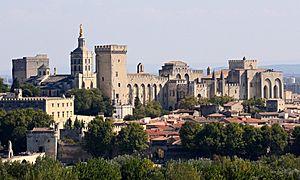Timeline of Avignon facts for kids
Welcome to the exciting history of Avignon, a famous city in southern France! This timeline will take you on a journey through centuries, showing how Avignon grew from an ancient settlement into a city known for its amazing buildings and important past. Get ready to discover popes, kings, and big changes that shaped this incredible place.
Contents
- Early Days: Before the 1300s
- The 1300s: Popes in Avignon
- The 1400s: Changes and Repairs
- The 1500s: New Ideas and Challenges
- The 1600s: French Influence Grows
- The 1700s: Revolution and France's Control
- The 1800s: Growth and Modernization
- The 1900s: New Transport and Culture
- The 2000s: Into the New Millennium
Early Days: Before the 1300s
- Around 400s AD: The city gets its own religious leader, called a bishop, setting up the Diocese of Avignon.
- 500: Clovis I, a Frankish king, tries to take Avignon but changes his mind.
- 737: The Frankish leader Charles Martel captures the town after a long fight.
- 1054: A big split happens in the Christian church, creating the Roman Catholic Church and the Eastern Orthodox Church. Avignon becomes very important for the Pope in the Catholic Church.
- Around 1129: Avignon starts to govern itself, a period called the Commune.
- 1185: The famous Pont Saint-Bénézet (bridge) is finished.
- Around 1220: New city walls are built to protect the growing town.
- 1226: The French king Louis VIII of France takes Avignon after a three-month siege.
- 1251: The Commune ends, and the brothers of Louis IX of France, Alphonse of Poitiers and Charles I of Anjou, take control.
- 1290: Charles II of Naples becomes the only ruler of Avignon.
The 1300s: Popes in Avignon
- 1303: The University of Avignon is founded, bringing learning to the city.
- 1309: Pope Clement V moves to Avignon. This starts the period known as the Avignon Papacy, where popes lived in Avignon instead of Rome.
- 1335: Building begins on the huge Palais des Papes (Pope's Palace) under Pope Benedict XII.
- 1348:
* Pope Clement VI buys Avignon from Joanna, the countess of Provence, for a lot of money. * The terrible Black Death arrives, killing about half of the city's people.
- Around 1357: Construction starts on the impressive city walls to protect the city.
- 1376: Pope Gregory XI leaves Avignon and returns to Rome, ending the Avignon Papacy.
- 1378: A new split, the Western Schism, begins. There are now two popes: one in Avignon and one in Rome.
The 1400s: Changes and Repairs
- 1417: The Western Schism ends with the election of Pope Martin V in Rome.
- 1475: The Diocese of Avignon becomes an archdiocese, a more important religious area.
- 1479–1488: The city walls are fixed and changed, reducing the number of gates.
- 1481: Avignon becomes like an island of papal land when the area around it, Provence, becomes part of France.
The 1500s: New Ideas and Challenges
- 1517: Important scholars come to teach at the University of Avignon.
- 1561: Pope Pius IV sends his cousin to help defend Avignon during the French Wars of Religion.
- 1580: Another outbreak of plague hits the city.
The 1600s: French Influence Grows
- 1662–1664: Louis XIV of France takes control of Avignon for a short time.
- 1669: The famous Pont Saint-Bénézet (bridge) is no longer used.
- 1688–1689: Louis XIV takes control of Avignon again.
The 1700s: Revolution and France's Control
- 1755: Severe floods cover more than three-quarters of the town.
- 1768–1774: Louis XV of France takes control of Avignon.
- 1791:
* During the French Revolution, Avignon officially becomes part of France. * A sad event called the Massacres of La Glacière happens.
- 1797: Pope Pius VI formally gives control of Avignon to France in a treaty.
The 1800s: Growth and Modernization
- 1800: The population of Avignon is 21,412 people.
- 1801: New administrative areas are created in the city.
- 1811: The Calvet Museum is established, a place for art and history.
- 1819: A new wooden bridge is built across the Rhône River.
- 1825: The Théâtre Municipal (Municipal Theater) opens.
- 1840: Another severe flood hits the town.
- 1849: A railway line opens, connecting Avignon with Marseille.
- 1854:
* A railway line opens, connecting Avignon with Paris. * A serious Cholera sickness spreads through the town.
- 1856: More severe flooding and a part of the city walls collapses.
- 1860: The Gare d'Avignon-Centre (train station) is built.
- 1899: Electric trams start running in Avignon.
The 1900s: New Transport and Culture
- 1901: The population grows to 43,453.
- 1913: The AC Arles-Avignon football (soccer) club is formed.
- 1935: The Rhône River causes serious flooding again.
- 1937: The Avignon-Caumont Aerodrome (airport) is established.
- 1944: During World War II, bombs are dropped on Avignon, damaging railway lines and houses. Many people are killed or injured.
- 1947: The famous Festival d'Avignon begins, a major arts festival.
- 1975: The Parc des Sports (Avignon) (stadium) opens. The population reaches 90,786.
- 1982: Avignon becomes part of the Provence-Alpes-Côte d'Azur region of France.
- 1984: The Avignon Film Festival begins, and the Université d'Avignon is created.
- 1997: The main campus of the Université d’Avignon is established.
The 2000s: Into the New Millennium
- 2001:
* The Gare d'Avignon TGV (high-speed train station) opens. * The Grand Avignon regional government is created.
- 2003: Flooding affects parts of the town.
- 2006: The population is around 90,800.
- 2009: The Vélopop' bikeshare system starts, letting people rent bikes.
- 2014: Cécile Helle becomes the mayor of Avignon.


